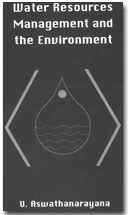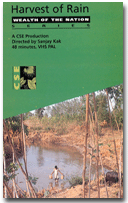| |
A NEW BEGINNING |
|
| By the people |
||
IN FOCUS |
||
| Open letter to the Prime Minister Atal Bihari Vajpayee Khandwa,Catching every droplet The lost pond |
||
CAMPAIGN |
||
| From the courtroom Face to face Destroy, then revive |
||
INITIATIVE |
||
| Woman power Paying up A tiny oasis in Uttar Pradesh Smile! CII’s water meet Rotary’s initiative Brick by brick Nurturing the future CSE’s pilgrims in Madhya Pradesh Taking initiative Experiments with water |
||
NEWS FROM GUJARAT |
||
| Pure
rain In a great hurry! |
||
JAL BIRADARI |
||
| As
priceless as amrit Reviving pynes |
||
JAL YODHA |
||
| D
V Subramanaian Ashutosh Agnihotri |
||
NEWS FROM CHENNAI |
||
| Rain centre inaugurated The Alacrity cycle Porous roads Plumbers’ meet Women’s meet |
||
CSE' LATEST DESIGNS |
||
| Making
a mark in Laburnam |
||
TECHNOLOGY |
||
| Pollutants
to bind roads Make your own rain gauge Smart farming tool Techno tit bits |
||
NEWS FROM ABROAD |
||

| Vol. 4 | No. 4 |
August-September 2002 |
Glimpses of books
U Aswathanarayana A A Balkema Publishers, The Netherlands, 2001, pp 422, US$ 47.50 (PB) This book is about water resource planning and management, which is not a new field. The outstanding feature of this work is that the author has effectively integrated the two streams of science of water and the management of water. This eminently readable book has 12 chapters. The first three chapters deal with the principles of hydrogeology, dynamics of water environments and water quality. Following eight chapters concentrate on the application of the technology. It concludes by outlining the different paradigms of water management from techno-socio-economic perspective. The book takes a refreshing approach, often challenging the established practices. With the help of the case studies, the author suggest ways of popularising the use of wastewater among people. While recognising the shortfall in the supply of water for irrigation, the author outlines several techniques to improve utilisation and its supply. The problems in desalinisation for both sea and brackish waters has been effectively dealt with. The author smoothly integrates the technical scope of managing water resources with the institutional issues. Different methodologies for analysing the economic cost of water are also clearly laid out. The list of literature provided at the end of the book is valuable. It will particularly benefit the university students and professionals with an interest in natural resources management.
|
 Water
resources
Water
resources 